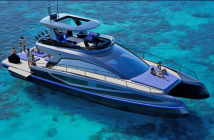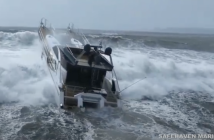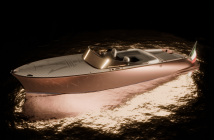I’ve been following boating traffic on the harrowing Northwest Passage ever since my friend Sprague Theobald cruised 8,500 miles from Newport, Rhode Island, to Seattle, on his Nordhavn 57 Bagan in 2009 (see photo above). Theobald, an award-winning documentary film maker, wrote about that trip in his gripping book, The Other Side of the Ice. His crew included his son, stepson and stepdaughter. At one point, when Bagan was trapped in ice that threatened to crush the hull, Theobald asked himself, “Have I brought my family together only to lead them to their deaths?”
Since then, with global warming and melting ice, there’s been increasing traffic through the Northwest Passage, and not always with happy results. Three years ago, a passenger ship ran aground on an uncharted shoal in the Canadian Arctic. All 163 people on board were rescued, a remarkable feat, but the boat suffered major hull damage.
Now the Transportation Safety Board of Canada has released a report identifying several safety measures, as well as risks, that face boats in the Northwest Passage. Here’s the report:
By Clifford Harvey, Director of Marine Investigations at the Transportation Safety Board of Canada
On 24 August 2018, the passenger vessel Akademik Ioffe ran aground in the Canadian Arctic. The vessel was sailing through a remote area where none of the crew had ever been before, and which was not surveyed to modern hydrographic standards. Although no one was injured and all 163 persons on board were rescued, the vessel sustained major damage to its hull. An investigation (M18C0225) by the Transportation Safety Board of Canada (TSB) identified a number of safety deficiencies, as well as risks to be addressed.
The vessel deviated from its original voyage plan over concerns about the weather impacting a planned passenger excursion. In preparing a new voyage plan to accommodate this, the master relied on a Canadian chart but was not aware it contained only partial bathymetric data, and he thus took no additional precautions to mitigate the risks of navigating in this area.
Meanwhile, the low-water depth aural alarms on both echo sounders—regarded as a nuisance—had been turned off. Just prior to the grounding, the Officer of the Watch was multi-tasking and the helmsman was steering the vessel. With no other crew engaged in monitoring the situation or navigation equipment, the under-keel water depth steadily decreased. The vessel ran aground on an uncharted shoal before evasive measures could be taken.
With more than 85 percent of Canadian Arctic waters having inadequate hydrographic data information, the likelihood of a similar occurrence involving passenger vessels engaged in adventure tourism is high. When incidents do occur, the cold, vast, and sparsely populated region presents additional risks to passenger survivability. This is compounded by a lack of timely search and rescue response in the area. Read more:
https://gcaptain.com/akademik-ioffe-passenger-vessel-grounding-risks-arctic-travel/




